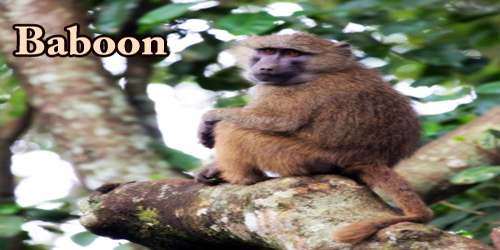Baboon (genus Papio) is one of the 23 genera of Old World monkeys. There are five species of baboons, commonly known as hamadryas baboon, a Guinea baboon, olive baboon, yellow baboon, and chacma baboon. Each species is native to one of five areas of Africa and the hamadryas baboon is also native to the part of the Arabian Peninsula. Baboons are among the largest non-hominoid primates and have existed for at least two million years. Males of the largest species, the chacma baboon (Papio ursinus), average 30 kg (66 pounds) or so, but females are only half this size. The smallest is the hamadryas, or sacred baboon (P. hamadryas), with males weighing about 17 kg and females only 10, but this still places them among the largest monkeys. Baboons range from 50 to 115 cm (20–45 inches) long, not including the 45–70-cm tail, which is carried in a characteristic arch. All species have long snouts with the nostrils located at the end; male baboons have long daggerlike canine teeth. Baboons are only found in a very specific area of the world: Africa and Arabia. Four species, the chacma, olive, yellow, and Guinea, live in the savannas. Others live in other semi-arid habitats, though some baboons can sometimes be found in tropical forests. The Hamadryas baboon lives in the hills along the Red Sea. Unlike other monkeys, baboons stay on the ground much of the time. They do sleep, eat or keep watch in trees, though.
Baboons are very social creatures. Groups of baboons are called troops, and a troop can contain dozens to hundreds of members. The largest troops have up to 300 members, according to the African Wildlife Federation. Troops groom, sleep, and protect each other. Young baboons in the troop will also play together. Games include wrestling, swinging from vines, and chase. A dominant male usually runs the troop. Males are usually ranked in dominance by age and size while females are usually ranked by birth order. In general, each male can mate with any female; the mating order among the males depends partly on their social rank. Females typically give birth after a six-month gestation, usually to one infant. The females tend to be the primary caretaker of the young, although several females may share the duties for all of their offspring. Offspring are weaned after about a year. They reach sexual maturity around five to eight years. Males leave their birth group, usually before they reach sexual maturity, whereas most females stay in the same group for their lives. Baboons in captivity live up to 45 years, while in the wild they average between 20 to 30 years.
Baboons belong to a large family of Old World monkeys (Cercopithecidae). Other long-faced monkeys, especially the mandrill and drill, the gelada, and the Celebes macaque, are sometimes referred to as baboons, but among these only the gelada is closely related. In the Guyanas and Belize, the term baboon is colloquially applied to the howler monkey. As omnivores, baboons eat a wide array of meats and plants. Typical foods in a baboon’s diet include grasses, fruits, seeds, roots, bark, rodents, birds, and the young of antelopes, sheep, and other mammals. They even eat other monkeys. Sometimes baboons make pests of themselves by eating crops nearby their homes. In Egyptian mythology, Babi was the deification of the hamadryas baboon and was therefore a sacred animal. It was known as the attendant of Thoth, so is also called the sacred baboon. The 2009 documentary Baboon Woman examines the relationship between baboons and humans in South Africa. Baboons can talk, sort of. They have at least 10 different vocalizations they use to communicate. Humans and baboons are closely related. They have a genetic similarity of 94 percent.
















